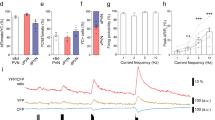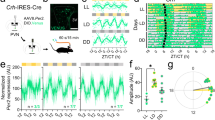Abstract
During stress, corticotropin-releasing hormone (CRH) and arginine vasopressin (AVP) released from parvocellular neurons in the hypothalamic paraventricular nucleus act synergistically to stimulate adrenocorticotrophic hormone (ACTH) secretion from corticotropes in the anterior pituitary gland. Using the patch clamp technique to monitor membrane potential or current in corticotropes obtained from transgenic mice expressing pro-opiomelanocortin-enhanced green fluorescent protein, we found that the TREK-1 channels, which belong to the class of two-pore domain K+ channels, have a major role in the setting of the resting membrane potential. Augmentation of the TREK-1 current by arachidonic acid resulted in hyperpolarization, while the inhibition of TREK-1 current by fluoxetine caused depolarization. CRH reduced the TREK-1 current via a cAMP/protein kinase A-dependent pathway, resulting in a sustained depolarization and the activation of voltage-gated Ca2+ channels. By contrast, AVP triggered Ca2+ release from the inositol 1, 4, 5 trisphosphate-sensitive stores which activated the small conductance Ca2+-activated K+ channels, resulting in a transient hyperpolarization. The hyperpolarization was followed by a sustained depolarization, which was due to the suppression of TREK-1 current by AVP via a protein kinase C-dependent pathway. AVP and CRH had an additive effect on the suppression of TREK-1 current, resulting in a more robust depolarization in corticotropes. In conclusion, the additive effect of CRH and AVP on the inhibition of TREK-1 channels in corticotropes is a major mechanism that underlies the synergistic action of these two hypothalamic hormones on ACTH release.
Access this chapter
Tax calculation will be finalised at checkout
Purchases are for personal use only
Similar content being viewed by others
References
Aguilera G, Harwood JP, Wilson JX, Morell J, Brown JH, Catt KJ (1983) Mechanisms of action of corticotropin-releasing factor and other regulators of corticotropin release in rat pituitary cells. J Biol Chem 258:8039–8045
Bilezikjian LM, Woodgett JR, Hunter T, Vale WW (1987) Phorbol ester-induced down-regulation of protein kinase C abolishes vasopressin-mediated responses in rat anterior pituitary cells. Mol Endocrinol 1:555–560
Borsotto M, Veyssiere J, Moha Ou MH, Devader C, Mazella J, Heurteaux C (2015) Targeting two-pore domain K(+) channels TREK-1 and TASK-3 for the treatment of depression: a new therapeutic concept. Br J Pharmacol 172:771–784
Braun G, Lengyel M, Enyedi P, Czirjak G (2015) Differential sensitivity of TREK-1, TREK-2 and TRAAK background potassium channels to the polycationic dye ruthenium red. Br J Pharmacol 172:1728–1738
Canny BJ, Jia LG, Leong DA (1992) Corticotropin-releasing factor, but not arginine vasopressin, stimulates concentration-dependent increases in ACTH secretion from a single corticotrope. Implications for intracellular signals in stimulus-secretion coupling. J Biol Chem 267:8325–8329
Cowley MA, Smart JL, Rubinstein M, Cerdan MG, Diano S, Horvath TL, Cone RD, Low MJ (2001) Leptin activates anorexigenic POMC neurons through a neural network in the arcuate nucleus. Nature 411:480–484
Dedman A, Sharif-Naeini R, Folgering JH, Duprat F, Patel A, Honore E (2009) The mechano-gated K(2P) channel TREK-1. Eur Biophys J 38:293–303
Enyeart JJ, Enyeart JA (2013) Ca2+ and K+ channels of normal human adrenal zona fasciculata cells: properties and modulation by ACTH and AngII. J Gen Physiol 142:137–155
Enyedi P, Czirjak G (2010) Molecular background of leak K+ currents: two-pore domain potassium channels. Physiol Rev 90:559–605
Fink M, Duprat F, Lesage F, Reyes R, Romey G, Heurteaux C, Lazdunski M (1996) Cloning, functional expression and brain localization of a novel unconventional outward rectifier K+ channel. EMBO J 15:6854–6862
Gillies GE, Linton EA, Lowry PJ (1982) Corticotropin releasing activity of the new CRF is potentiated several times by vasopressin. Nature 299:355–357
Heurteaux C, Lucas G, Guy N, El YM, Thummler S, Peng XD, Noble F, Blondeau N, Widmann C, Borsotto M, Gobbi G, Vaugeois JM, Debonnel G, Lazdunski M (2006) Deletion of the background potassium channel TREK-1 results in a depression-resistant phenotype. Nat Neurosci 9:1134–1141
Labrie F, Veilleux R, Lefevre G, Coy DH, Sueiras-Diaz J, Schally AV (1982) Corticotropin-releasing factor stimulates accumulation of adenosine 3′, 5′-monophosphate in rat pituitary corticotrophs. Science 216:1007–1008
Lee AK, Tse A (1997) Mechanism underlying corticotropin-releasing hormone (CRH) triggered cytosolic Ca2+ rise in identified rat corticotrophs. J Physiol 504:367–378
Lee AK, Tse A (2001) Endocytosis in identified rat corticotrophs. J Physiol 533:389–405
Lee AK, Tse A (2005) Dominant role of mitochondria in calcium homeostasis of single rat pituitary corticotropes. Endocrinology 146:4985–4993
Lee AK, Smart JL, Rubinstein M, Low MJ, Tse A (2011) Reciprocal regulation of TREK-1 channels by arachidonic acid and CRH in mouse corticotropes. Endocrinology 152:1901–1910
Lee AK, Tse FW, Tse A (2015) Arginine vasopressin potentiates the stimulatory action of CRH on pituitary corticotropes via a protein kinase C-dependent reduction of the background TREK-1 current. Endocrinology 156:3661–3672
Lesage F, Guillemare E, Fink M, Duprat F, Lazdunski M, Romey G, Barhanin J (1996) TWIK-1, a ubiquitous human weakly inward rectifying K+ channel with a novel structure. EMBO J 15:1004–1011
Link H, Dayanithi G, Fohr KJ, Gratzl M (1992) Oxytocin at physiological concentrations evokes adrenocorticotropin (ACTH) release from corticotrophs by increasing intracellular free calcium mobilized mainly from intracellular stores. Oxytocin displays synergistic or additive effects on ACTH-releasing factor or arginine vasopressin-induced ACTH secretion, respectively. Endocrinology 130:2183–2191
Murbartian J, Lei Q, Sando JJ, Bayliss DA (2005) Sequential phosphorylation mediates receptor- and kinase-induced inhibition of TREK-1 background potassium channels. J Biol Chem 280:30175–30184
Roper J, O’Carroll AM, Young W III, Lolait S (2011) The vasopressin Avpr1b receptor: molecular and pharmacological studies. Stress 14:98–115
Sandoz G, Douguet D, Chatelain F, Lazdunski M, Lesage F (2009) Extracellular acidification exerts opposite actions on TREK1 and TREK2 potassium channels via a single conserved histidine residue. Proc Natl Acad Sci U S A 106:14628–14633
Smith SM, Vale WW (2006) The role of the hypothalamic-pituitary-adrenal axis in neuroendocrine responses to stress. Dialogues Clin Neurosci 8:383–395
Talley EM, Solorzano G, Lei Q, Kim D, Bayliss DA (2001) CNS distribution of members of the two-pore-domain (KCNK) potassium channel family. J Neurosci 21:7491–7505
Thummler S, Duprat F, Lazdunski M (2007) Antipsychotics inhibit TREK but not TRAAK channels. Biochem Biophys Res Commun 354:284–289
Tse A, Hille B (1994) Patch clam** studies on identified pituitary gonadotropes in vitro. In: Levine J (ed) Methods in neurosciences. Academic Press, Orlando, pp 85–99
Tse A, Lee AK (1998) Arginine vasopressin triggers intracellular calcium release, a calcium-activated potassium current and exocytosis in identified rat corticotropes. Endocrinology 139:2246–2252
Tse A, Lee AK (2000) Voltage-gated Ca2+ channels and intracellular Ca2+ release regulate exocytosis in identified rat corticotrophs. J Physiol 528:79–90
Tse A, Tse FW (1998) Alpha-adrenergic stimulation of cytosolic Ca2+ oscillations and exocytosis in identified rat corticotrophs. J Physiol 512:385–393
Tse A, Lee AK, Tse FW (2012) Ca2+ signaling and exocytosis in pituitary corticotropes. Cell Calcium 51:253–259
Vivier D, Bennis K, Lesage F, Ducki S (2016) Perspectives on the two-pore domain Potassium Channel TREK-1 (TWIK-related K(+) channel 1). A novel therapeutic target? J Med Chem 59:5149–5157
Won JG, Orth DN (1990) Roles of intracellular and extracellular calcium in the kinetic profile of adrenocorticotropin secretion by perifused rat anterior pituitary cells. I. Corticotropin-releasing factor stimulation. Endocrinology 126:849–857
Won JG, Oki Y, Orth DN (1990) Roles of intracellular and extracellular calcium in the kinetic profile of adrenocorticotropin secretion by perifused rat anterior pituitary cells. II. Arginine vasopressin, oxytocin, and angiotensin-II stimulation. Endocrinology 126:858–868
Author information
Authors and Affiliations
Corresponding author
Editor information
Editors and Affiliations
Key References: See Main List for Reference Details
Key References: See Main List for Reference Details
-
Enyedi and Czirjak (2010). Review on TREK-1 channels and other K2P channels.
-
Lee and Tse (1997). First demonstration of the reduction of a background K+ current by CRH.
-
Lee et al. (2011). Identification of TREK-1 channels as the target of CRH.
-
Lee et al. (2015). Demonstration of the additive effect of AVP and CRH on TREK-1 current and depolarization.
-
Tse et al. (2012). Review on Ca2+ homeostasis, exocytosis, and endocytosis in corticotropes.
-
Vivier et al. (2016). List of TREK-1 activators and inhibitors.
Rights and permissions
Copyright information
© 2020 Springer Nature Switzerland AG
About this chapter
Cite this chapter
Tse, A., Lee, A.K., Tse, F.W. (2020). Role of the TWIK-Related Potassium (TREK)-1 Channels in the Regulation of Adrenocorticotropic Hormone (ACTH) Secretion from Pituitary Corticotropes. In: Lemos, J., Dayanithi, G. (eds) Neurosecretion: Secretory Mechanisms. Masterclass in Neuroendocrinology, vol 8. Springer, Cham. https://doi.org/10.1007/978-3-030-22989-4_11
Download citation
DOI: https://doi.org/10.1007/978-3-030-22989-4_11
Published:
Publisher Name: Springer, Cham
Print ISBN: 978-3-030-22988-7
Online ISBN: 978-3-030-22989-4
eBook Packages: Biomedical and Life SciencesBiomedical and Life Sciences (R0)




